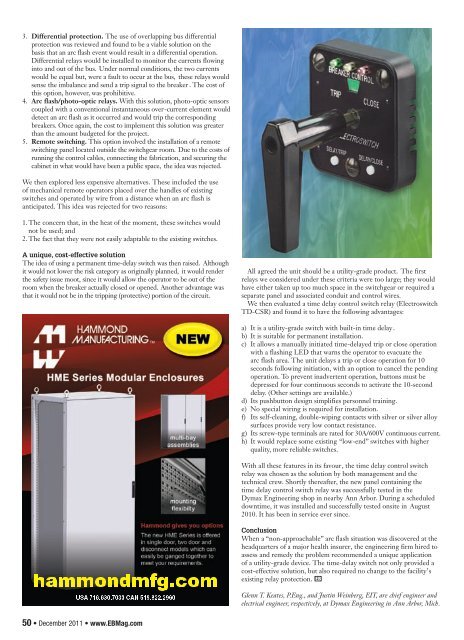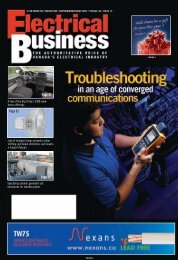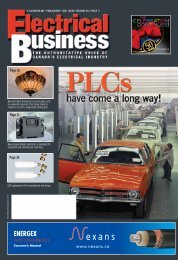DECEMBER 2011 - Electrical Business Magazine
DECEMBER 2011 - Electrical Business Magazine
DECEMBER 2011 - Electrical Business Magazine
Create successful ePaper yourself
Turn your PDF publications into a flip-book with our unique Google optimized e-Paper software.
3. Differential protection. The use of overlapping bus differential<br />
protection was reviewed and found to be a viable solution on the<br />
basis that an arc flash event would result in a differential operation.<br />
Differential relays would be installed to monitor the currents flowing<br />
into and out of the bus. Under normal conditions, the two currents<br />
would be equal but, were a fault to occur at the bus, these relays would<br />
sense the imbalance and send a trip signal to the breaker . The cost of<br />
this option, however, was prohibitive.<br />
4. Arc flash/photo-optic relays. With this solution, photo-optic sensors<br />
coupled with a conventional instantaneous over-current element would<br />
detect an arc flash as it occurred and would trip the corresponding<br />
breakers. Once again, the cost to implement this solution was greater<br />
than the amount budgeted for the project.<br />
5. Remote switching. This option involved the installation of a remote<br />
switching panel located outside the switchgear room. Due to the costs of<br />
running the control cables, connecting the fabrication, and securing the<br />
cabinet in what would have been a public space, the idea was rejected.<br />
We then explored less expensive alternatives. These included the use<br />
of mechanical remote operators placed over the handles of existing<br />
switches and operated by wire from a distance when an arc flash is<br />
anticipated. This idea was rejected for two reasons:<br />
1. The concern that, in the heat of the moment, these switches would<br />
not be used; and<br />
2. The fact that they were not easily adaptable to the existing switches.<br />
A unique, cost-effective solution<br />
The idea of using a permanent time-delay switch was then raised. Although<br />
it would not lower the risk category as originally planned, it would render<br />
the safety issue moot, since it would allow the operator to be out of the<br />
room when the breaker actually closed or opened. Another advantage was<br />
that it would not be in the tripping (protective) portion of the circuit.<br />
All agreed the unit should be a utility-grade product. The first<br />
relays we considered under these criteria were too large; they would<br />
have either taken up too much space in the switchgear or required a<br />
separate panel and associated conduit and control wires.<br />
We then evaluated a time delay control switch relay (Electroswitch<br />
TD-CSR) and found it to have the following advantages:<br />
a) It is a utility-grade switch with built-in time delay.<br />
b) It is suitable for permanent installation.<br />
c) It allows a manually initiated time-delayed trip or close operation<br />
with a flashing LED that warns the operator to evacuate the<br />
arc flash area. The unit delays a trip or close operation for 10<br />
seconds following initiation, with an option to cancel the pending<br />
operation. To prevent inadvertent operation, buttons must be<br />
depressed for four continuous seconds to activate the 10-second<br />
delay. (Other settings are available.)<br />
d) Its pushbutton design simplifies personnel training.<br />
e) No special wiring is required for installation.<br />
f) Its self-cleaning, double-wiping contacts with silver or silver alloy<br />
surfaces provide very low contact resistance.<br />
g) Its screw-type terminals are rated for 30A/600V continuous current.<br />
h) It would replace some existing “low-end” switches with higher<br />
quality, more reliable switches.<br />
With all these features in its favour, the time delay control switch<br />
relay was chosen as the solution by both management and the<br />
technical crew. Shortly thereafter, the new panel containing the<br />
time delay control switch relay was successfully tested in the<br />
Dymax Engineering shop in nearby Ann Arbor. During a scheduled<br />
downtime, it was installed and successfully tested onsite in August<br />
2010. It has been in service ever since.<br />
Conclusion<br />
When a “non-approachable” arc flash situation was discovered at the<br />
headquarters of a major health insurer, the engineering firm hired to<br />
assess and remedy the problem recommended a unique application<br />
of a utility-grade device. The time-delay switch not only provided a<br />
cost-effective solution, but also required no change to the facility’s<br />
existing relay protection.<br />
Glenn T. Keates, P.Eng., and Justin Weinberg, EIT, are chief engineer and<br />
electrical engineer, respectively, at Dymax Engineering in Ann Arbor, Mich.<br />
50 • December <strong>2011</strong> • www.EBMag.com

















